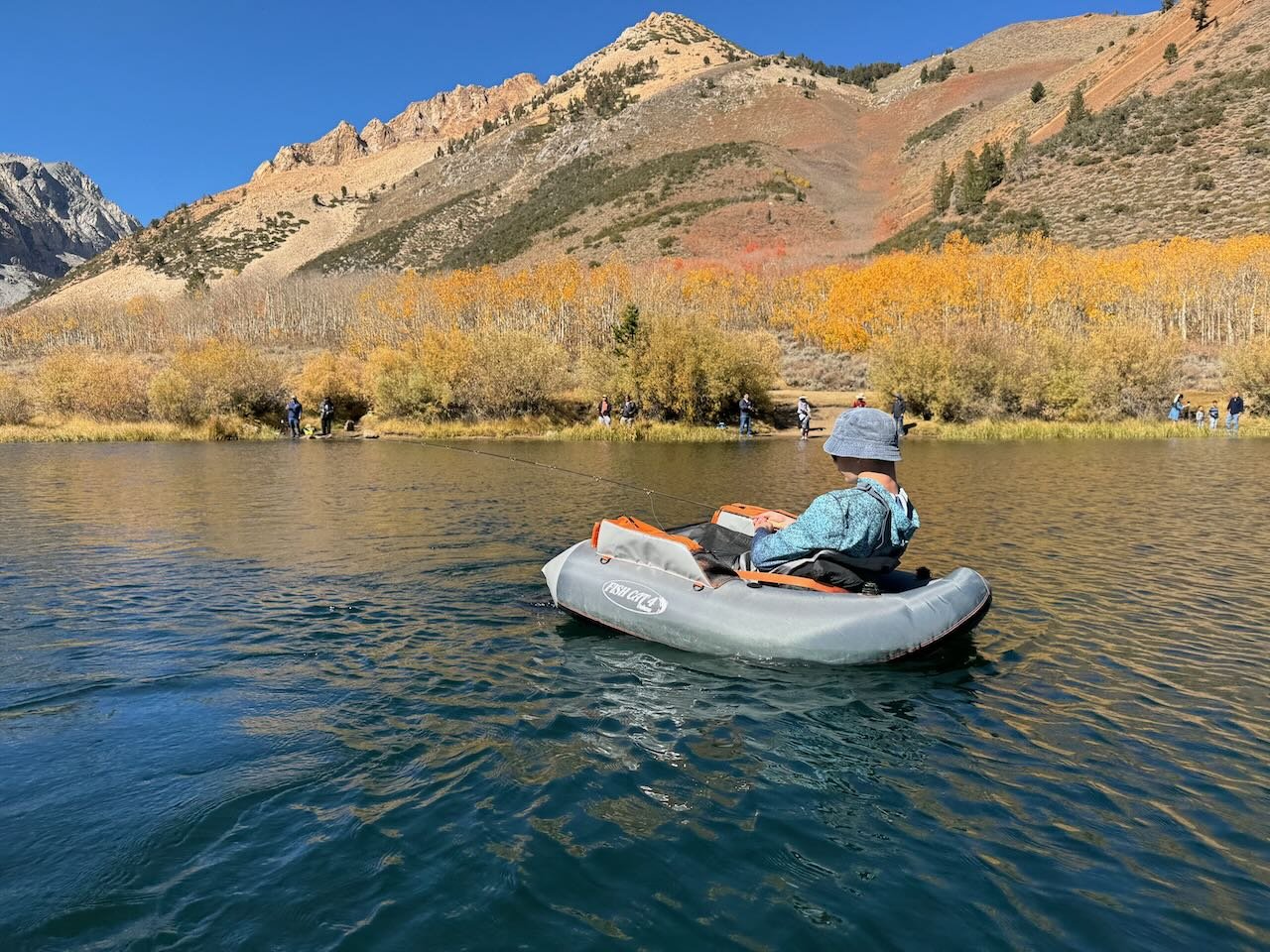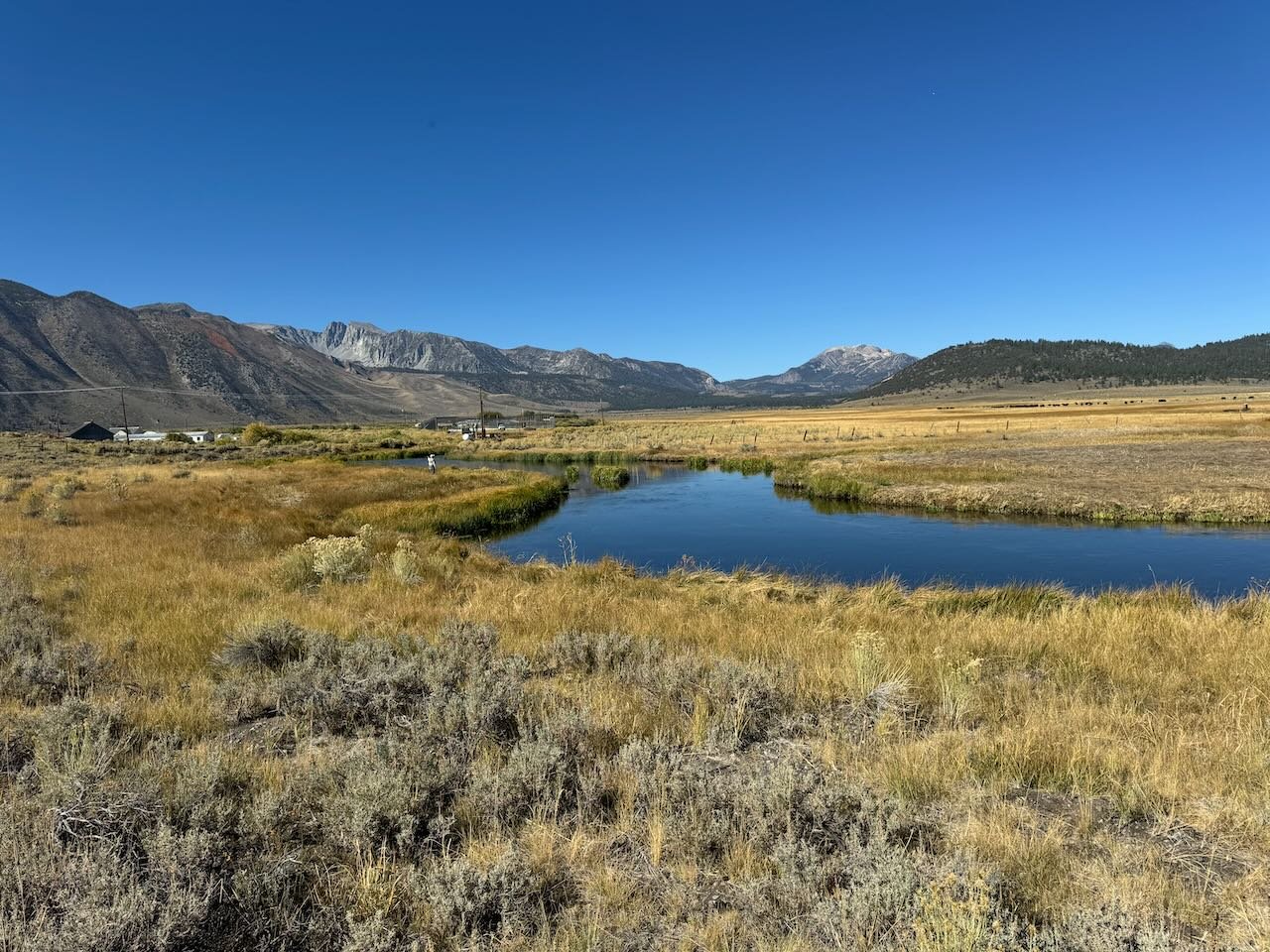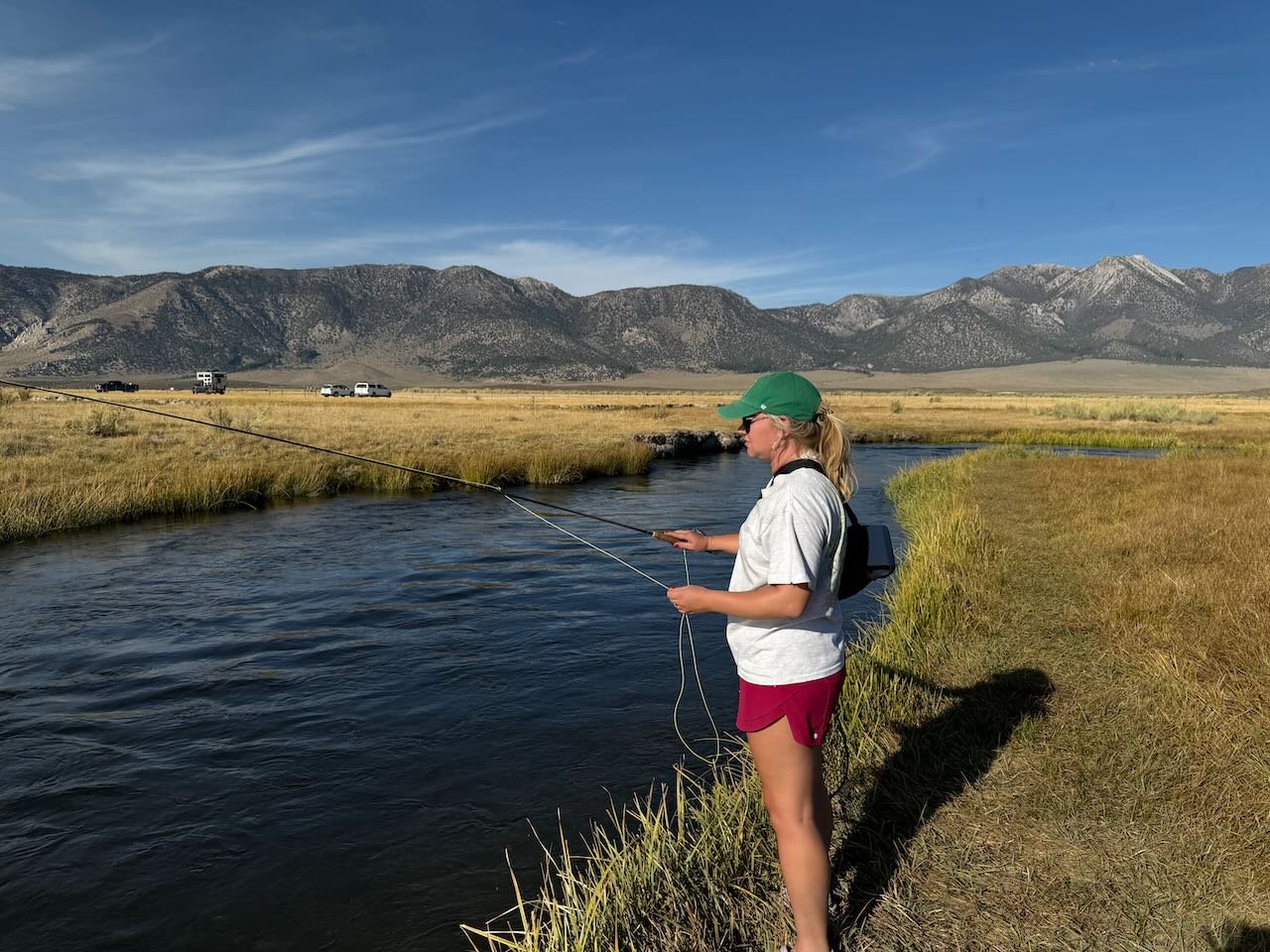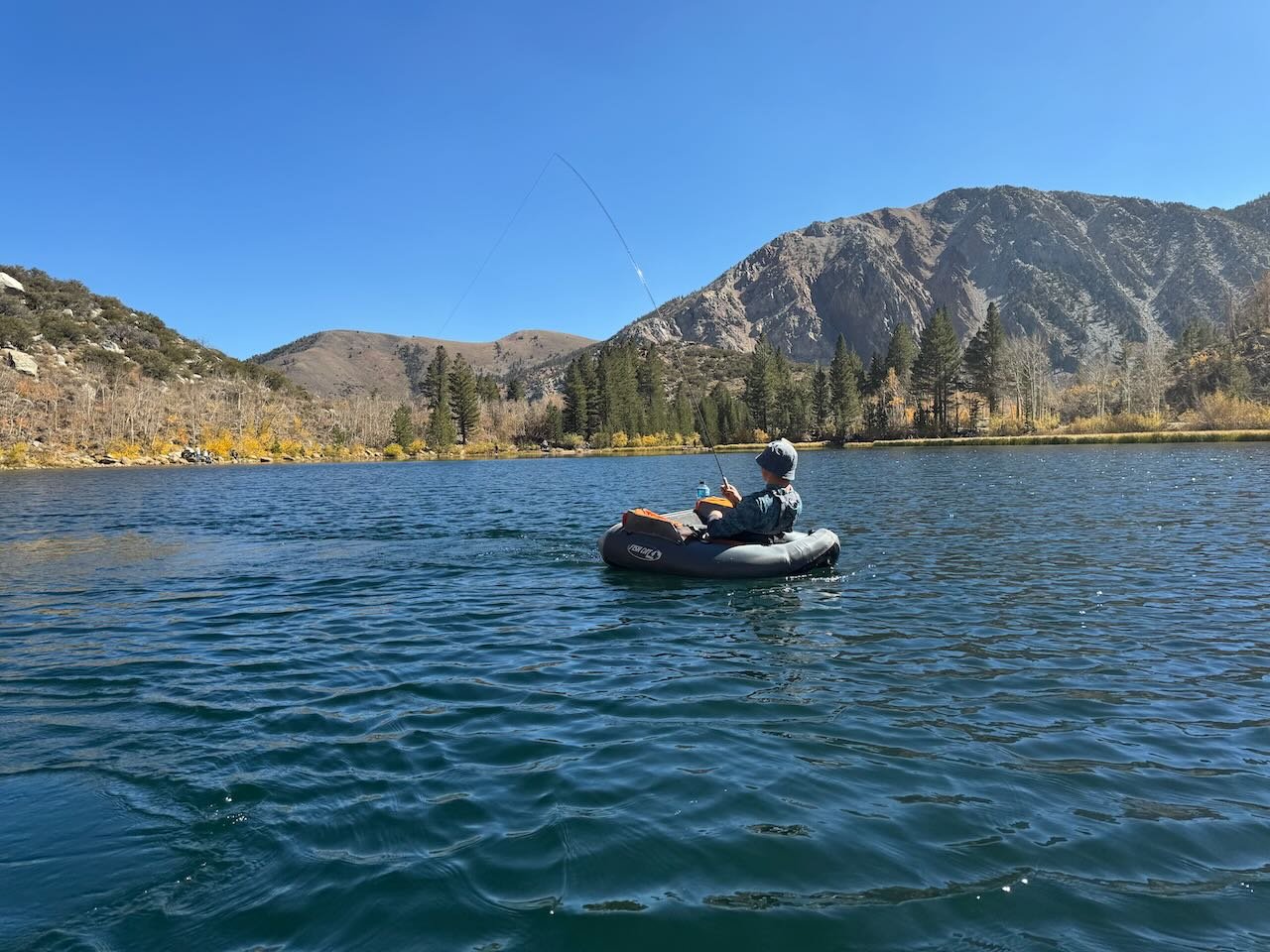The Eastern Sierra is due for a change in the weather. Cooler weather with a chance of snow at upper elevations. Then the question is will it warm up or is winter knocking on the door. I get up every day to see what weather we will have and plan out my day. Spawning brown and brook trout are offering fly fishers the opportunity for trophy brown trout and quantity brook trout. Hatches of mayflies, midges and caddis continue to feed trout on the substrate and on the streams surface. High country fly fishing opportunities are coming to an end as winter snows will be on the ground soon. Fall colors are about over at high elevations and are slowly moving downhill towards the Owens Valley.
Leaves are quickly falling and soon the trees will be bare of leaves and high altitude waters will become inaccessible.
Lower Owens River
Wild Trout Section:
Flows of 450 CFS is too high to safely wade the lower Owens River. Expect the flows to reduce by the end of the month. Flows under 300 CFS are safely wadable. Flows under 200 CFS are very fishable. Once flows reduce down the fly fishing on the lower Owens River will be good with nymphs.
At flows of 450 CFS there is little opportunity to wade or fly fish from the bank.
Hot Creek
Interpretive Site:
Caddis, tricos and bluewing olives are the insects the trout are feeding on. The mornings start off with a caddis migration. This is thousands of caddis flying upstream before they reproduce and lay their eggs. Caddis are poor fliers and the caddis that crash onto the water are feed upon by the trout. Use size 14 to 20 elk hair caddis, parachute caddis and October caddis. Following the caddis migration is the trico hatch. It starts with the duns hatching. Use a size 22 parachute trico or female trico parachute. After the dun stage the trico molt into the sexually mature spinner. After mating and laying their eggs the tricos die on the surface of the water. Fly fish with a size 22 trico spinner. Blue wing olive parachutes in size 22 have been producing trout at the end of the trico hatch.
Success on the Interpretive Site is a drag free drift and a fly pattern that imitates the stage of the insect the trout are feeding on.
Hot Creek
Canyon Section:
With a stepper gradient in the canyon section the trout are not as selective as in the Interpretive Site. Your drifts and fly patterns still need to be accurate, but the trout will accept less then perfection. A dry and dry or dry and dropper are two rigs to fly fish with in the canyon section. For the dry fly use a size 16 Adams parachute, size 14 stimulator and size 12 Chernobyl ant. For the nymph fish with a size 18 tiger midges, size 18 zebra midge, size 18 blood midge, size 18 olive quilldigon, size 18 bead head flash back pheasant tail nymph and size 18 SOS nymph.
To get out on Crowley Lake fly fishers are using a variety of water craft to pull streamers and midge under an indicator.
Crowley Lake
Mouth of the Owens River:
The flotilla of boats, float tubes, canoes, kayaks and boats is concentrating their effort on the north arm of Crowley Lake. Some fly fishers are using sinking lines and streamers to fish in 10 to 20 feet of water. Pulling size 6 and 10 wooly buggers in olive, black and purple, olive matukas and marabou muddles in olive and black and size 10 balanced leeches in black and in perch fry colors. Midging under an indicator with size 18 tiger midges, zebra midges, blood midges, gray midges and albino Barron’s in 10 to 20 feet of water is producing trout.
Is shorts and T-shirts behind us on when fly fishing the upper Owens River as a storm blows through the Eastern Sierra.
Upper Owens River
Above Benton Crossing Bridge:
Trophy brown trout are trickling into the upper Owens River and can be found from the mouth of Crowley to the Longyears area. If you want to catch one of these fish you need to fish with bigger flies like a size 12 stoner nymph, size 12 green/gold Prince nymph, size 14 copper John and size 12 gold ribbed hare’s ear in the deeper holes, deeper runs and cutbanks. Rainbows and browns from three inches to 12 inches are willing taking well-presented dries and nymphs. Under an indicator 1.5 to 2 times the average depth of water above the bottom fly is how you want to be nymphing with size 18 bead head flash back pheasant tail nymphs, size 16 bead head flash back gold ribbed hare’s ears, size 16 tiger or zebra midges and size 16 SOS nymphs. On the surface fish with size 20 trico parachutes, size 16 Adams parachutes, size 18 blue wing olive parachutes and size 16 elk hair caddis.
Trolling a size 14 olive wooly bugger behind the float tube produced lots of stocked rainbow trout for Jordan Souter from Australia.
North Lake:
North Lake got a planting of hatchery rainbows that are all over the lake taking nymphs, dries and streamers. Trolling an olive size 14 wooly bugger behind a float tube proved to be the hot ticket for my client from Australia who had a great day landing over 30 rainbows and one brown trout to 12 inches. Using a dry and dropper with a size 16 Adams parachute and a size 16 bead head flash back pheasant tail nymph is fooling the rainbows who are taking the nymph as much as they’re taking the dry. Lots of fall color lookers were all over the lake taking advantage of the fall colors. The colors on North Lake have peaked and should be totally gone by the end of next week.
From the inlet to Weir Pond through Weir Pond rainbows browns and brook trout are taking dries and nymphs.
Bishop Creek
South Fork at Weir Pond:
The leaves are quickly falling from the trees lining Weir Pond. The trout are continuing to take dries and nymph fished to them. For dries try fly fishing with size 16 Adams parachutes, size 14 elk hair caddis and size 14 royal Wulff’s. For the nymphs fish with size 16 bead head flash back gold ribbed hare’s ears, size 18 bead head flash back pheasant tail nymphs and size 16 tiger and zebra midges. Waders and a jacket are necessary on the creek particularly in the evenings and when the wind is blowing.
Working the flats on Bishop Creek Canal with a nymph under an indicator or a Euro rig is producing wild brown trout and stocked rainbow trout.
Bishop Creek Canal
Behind Bishop Veterinary Hospital:
Under an indicator or with a Euro rig fly fishers presenting nymphs to the trout in Bishop Creek Canal are producing trout. On the Euro rig fish with a size 12 green/gold Prince nymph, size 12 stoner nymph, size 18 olive quilldigon and a size 16 hot spot pheasant tail nymph. Under the indicator fish with a size 16 tiger or zebra midge, size 16 bead head flash back pheasant tail nymph and a size 18 bead head flash back pheasant tail nymph.








